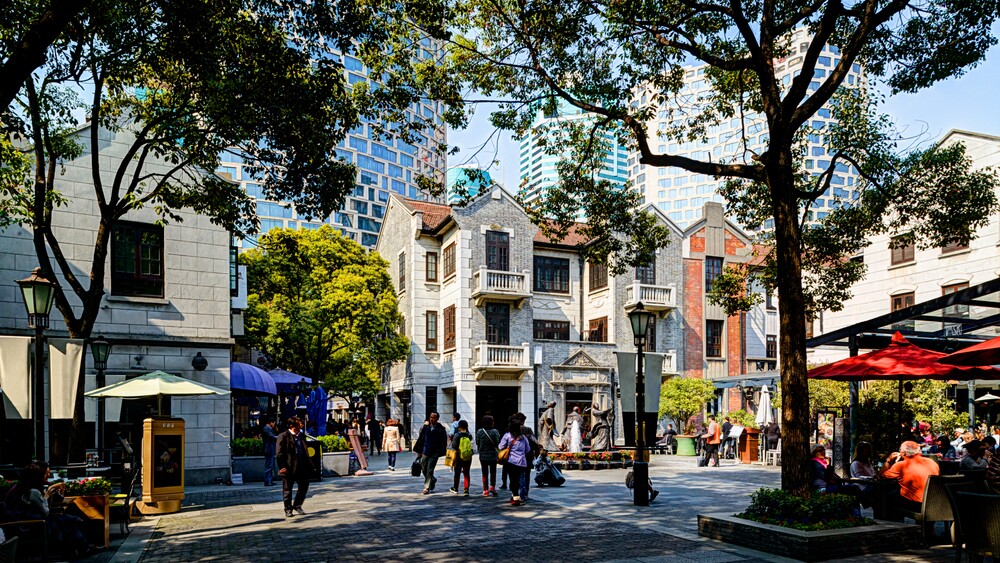Invited by Hong Kong tycoon and real estate developer Vincent Lo to create a public space in Shanghai’s city center, world-famous American architect Ben Wood designed the now-famous Shanghai Xintiandi—meaning “New Heaven and Earth.” Open to the public over two decades ago, the project both preserved the old Shanghai architectural style known as “shikumen” (stone door), while creating a low-density outdoor area of restaurants and entertainment amid the bustling office towers and high-rise apartments of downtown. The project has served as a valuable example for numerous urban regeneration projects in mainland China and helped retain historical buildings and other elements in urban centers while the country underwent a rapid urbanization.
The outstanding project soon became internationally recognized and was the first ULI Global Awards for Excellence winner from the mainland.
Though Wood and I had met several times over the previous decade, we never had a chance to have an in-depth discussion about his career. I was fortunate to interview him at the ULI China Annual Meeting in December 2021, with an audience of about 200 ULI members.
The path to world-class architect
One of my first questions was what helped Wood prepare to become a world-class architect. Surprisingly, he credited his rural upbringing outside of Atlanta, and his experiences as a U.S. Air Force pilot in Europe during the Cold War.
Wood explained that growing up on a farm meant a lot of physical labor, even when it came to having fun, like building treehouses and playing sports. He also said that flying over Europe in an F-4 Phantom II fighter jet sharpened his perception and appreciation of three-dimensional space—an experience uniquely suited to his ultimate career. During our dialogue, Wood mentioned that he had been working on an autobiography, which has since been published.
In late 2023, as I was preparing to return to the U.S. and settle outside Atlanta near Wood’s hometown of Roswell, I thought it would be worthwhile to reconnect with him again before I left. We ended up having another long conversation in his Shanghai studio. He introduced me to his younger brother, Jere, a former long-time mayor of Roswell, and signed a copy of his book, Into the Dragon’s Mouth: Stories from an American Architect who Changed China.
Looking back, and forward
In the book, readers can see the steady progression of Wood’s education and career, from his pastoral childhood in rural Georgia to his teen years in greater Washington, D.C., where his father was part of the Kennedy Administration. After studying civil engineering at North Carolina State University, Wood joined the U.S. Air Force and began patrolling the skies over Europe for the next six years.
Architecture school at MIT followed when Wood was in his 30s. He then spent a decade working with Benjamin Thompson, the architect of Faneuil Hall Marketplace in Boston. Wood’s other projects in the U.S. include the renovation of Chicago’s Soldier Field, fresh facades for New York City’s Times Square, and the regeneration of Miami Beach’s Lincoln Road pedestrian retail area. In fact, it was the Lincoln Road project that first caught the eye of Hong Kong’s Lo, who then sought out Wood to develop what would become Shanghai Xintiandi.
The book describes the pivotal moments of Wood’s early life and professional career, told through colorful stories and revealing anecdotes. He tells of growing up in the segregated South with liberal, politically active parents, and the various people who affected him along the way. In 1967, the “Summer of Love,” Wood and his younger brother, along with some friends, bought a condemned Victorian mansion in Durango, Colorado, and renovated it—undoubtedly a valuable experience for the nascent architect.
Wood’s book also tells the behind-the-scenes stories of his signature projects and the “serendipity” of good timing. In the case of Soldier Field, for example, the chairman of the Chicago Bears organization happened to be one of Wood’s neighbors on Martha’s Vineyard. It was he who invited Wood to bid on the facility’s renovation.
For the revitalization of Lincoln Road, Wood describes how he cold-called the original architect, Morris Lapidus, after tracking him down in the Miami Yellow Pages. Wood credits his winning bid on the project to the many hours he spent with Lapidus, who was in his 90s at the time and long since retired.
A master’s approach to design
The book also describes Wood’s “contextualism” approach to large design projects like Xintiani. He tells of visiting the downtown Shanghai neighborhood for the first time, and his dismay at seeing multiple families crowded into single family townhouses amid open sewers.
Yet Wood also saw the beauty of the architecture in the city center and molded those design features into a modern public plaza with dining, shopping and entertainment. Xintiandi is now such a welcoming space that even Wood can’t stay away. When he’s not running his Studio Shanghai, he can often be found in his favorite Xintiandi bar after hours.
Ben Wood’s autobiography is available on Amazon and earnshawbooks.com.
Kenneth Rhee previously served as executive director of ULI China and is CEO of Integral VIM, a BIM consulting firm. He splits his time between Shanghai and Atlanta.






